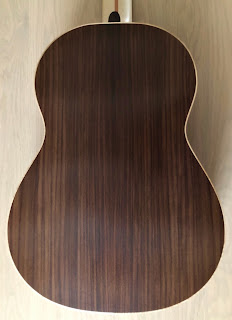Presented here is a Daniel Roye guitar, built in 1980.
Recently refretted and a neck / body angle correction.
This guitar is in a very good shape with no cracks or
whatsoever. Scale is 650 mm while the topnut is
54 mm. Daniel Roye continued with building violins
and is quite successful with it. He learned the craft
from Nicolaas van der Waals among others. Own
frequency from the body is a G so 98 Herz. Sold.
What immediately is remarkable is the way Roye shaped
the head. In fact the way a violin builder is supposed to
do. I can't find immediate advantages of it. The topnut
has been redressed after the fret job.
On par with the quality of a concert guitar the tuners should be
of pristine quality. And I can confirm that: They are! Clinched
with the axe holders to the base plate and very smoothly working.
The lyre motif is there as has been made popular by the Spanish
Barcelona based Fustero company but I think them to come
from Germany. And indeed they are: Daniel Roye confirmed
this: They are from "Sommer", a small workshop in Buben-
reuth. With this link you are able to find out more about
them:
The body that has been built up with fine grained spruce
and beautiful figured Brasilian rosewood for back and
sides. Also the purfling has been done in rosewood.
The dull looking spots are simply reflections though
there are some playing marks under the strings.
Nothing serious but the guitars' top has been
refinished with French polish but with the playing
marks still visible under it. Nothing serious but
it has to be mentioned to my opinion.
A surprisingly low bridge that hasn't been altered
by someone. The idea must have been that a lighter
bridge let's the top vibrate more freely. Moreover
the bridgebone is closer to the actual soundboard.
A newly made bridgebone adjusted for convenient
playability and stringsavers to get an even better
angle over the bridgebone though it was in fact
not necessary.
The guitar from the back. Beautiful woods used here!
The back in all its' beauty. It almost looks as if the
back exists out of only one piece of wood. The
seam is hardly detectable. The reflections are,
sorry for that....
A strange picture for classical guitar players I
suspect. The back of the head has been closed
with a layer of wood.
This picture is showing the recently placed new frets.
A 1980 guitar with a whole life in front of itself! And
with its' comfortable shaped neck it is an easy to play
guitar. As for sound: Not a very loud instrument but
it has a really nice low end and a good balance
between the lower and upper registers.
In fact the Amsterdam Guitar Trio played most of their music
on Daniel Roye's guitars so the sound can be judged there.
Search for the Vivaldi: The four Seasons The Amsterdam
guitar Trio. Soundwise I think the sound on this video is bit
thin when I compare it with my guitar. But the idea in how
a guitar should sound is changing over time. Also in the
recording world as the digital era was just starting in 1980.
A more recent recording on YouTube has been made by
Alex Timmerman with a Manuel Maria Ponce piece.
In every detail it is becoming clear that the luthier
did his best to produce a beautiful instrument. I will
try to contact him and maybe I will get some more
information around several details.


.jpeg)
























































